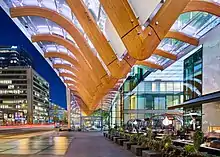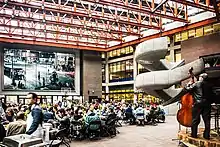Gregory Henriquez
Gregory Henriquez is a Canadian architect, best known for the design of complex community-based mixed-use projects in Vancouver and more recently in Toronto and Seattle. He is the managing principal of Henriquez Partners Architects.

Gregory Henriquez | |
|---|---|
| Born | 1963 |
| Nationality | Canadian |
| Alma mater | Carleton University, McGill University |
| Occupation | Architect |
| Practice | Henriquez Partners Architects |
| Projects | Woodward's Redevelopment |
| Design | Mirvish Village, Oakridge Redevelopment |
Background
Gregory Henriquez was born in 1963 in Winnipeg, Manitoba.[1] He received a bachelor's degree in architecture from Carleton University.[1] He joined his father Richard Henriquez' business as an employee and eventually became a managing partner of the firm.[1]
In Henriquez’ books Towards an Ethical Architecture (2006), Body Heat (2010), and Citizen City (2016) he discusses the role that architects can have in society and the place of ethics, activism and critical commentary within contemporary practice.[2]:1938 In the books, Henriquez states that he grapples with these themes in his practice: overcoming the collective amnesia of architecture's ethical dimension and exploring a sense of authentic expression beyond conventional style to ultimately nurture the growth of an inclusive city.[2]:1938
Poetic Expression of Social Justice
One example of Henriquez placing a focus upon social considerations in his architecture was 60 West Cordova, a prototype of affordable residential ownership in Vancouver for moderate income households.[3]:253 The project features a floor of twelve non-market housing units that were sold at cost to two non-profit organizations, PHS Community Services Society and Habitat for Humanity.[3]:248 Then, the housing units were indexed to the local cost of living and sold at below-market rates.[3]:248 In an effort to create an internal community within the building that had an existing connection to the immediate neighbourhood, each purchaser had to prove that they currently worked, lived or volunteered in the Downtown Eastside, Gastown or Chinatown.[3]:245–247 Bruce Eriksen Place is another example of an architectural project by Henriquez with a societal and community-based approach to design issues.[2]:1938 The project has 35 self-contained housing units for low-income residents and was completed with the help of Vancouver advocate Jim Green, who was able to increase government funding for the project and raise the average unit size to 40m² from the proposed 19m².[4]:79 Additional examples of Henriquez's socially-conscious architecture are the mixed-use, mixed-income Woodward's Redevelopment, which was the centerpiece of a major urban renewal scheme,[5][6] Central Presbyterian Church,[3]:68 Lore Krill Housing Cooperative,[4]:129 and Immigrant Services Society of BC,[3]:68 all of which are in Vancouver.
Inclusive Cities
In the book, Citizen City (2016), Henriquez promotes his vision for the ideal city, one that “transcends the traditional urban goals of economic stability and working infrastructure, and allows for inclusivity of its people, with a variety of economic levels, different cultures, and diverse identities.” This concept encourages democratic and civic engagement, as well as cultural and community development.[3]:1
Political Advocacy and Public Consultation
Henriquez considers the political dimension of architecture an important responsibility of the architect's role.[3]:IX As one example, for the Woodward's Redevelopment in Vancouver's Downtown Eastside, the project required the architect to fulfill many different stakeholder needs in both the public and private sectors.[4]:161 This requirement necessitated expanding the mandate of the architect to encompass spheres of activity not typically considered to be the architect's responsibility, and led to Henriquez negotiating with the City of Vancouver on behalf of the project's developer.[4]:161 Henriquez has stated that when approaching city policies, it is important to understand the intentions of the policy if hoping to get beneath the surface of its rules and regulations.[3]:281–282 To quote Henriquez, "If you can find a way to understand the intentions, and if they are good, then there's often a way to work around perceived limitations."[3]:282 Procedurally, Henriquez utilizes public consultation to catalyze public support towards an outcome that contributes to a project's community.[3]:286 Public consultation was a meaningful part of the design process for the Mirvish Village development in Toronto, built upon the site of the locally renowned Honest Ed's retail store.[3]:286

Projects
Woodward's Redevelopment
At $475 million, the Woodward's Redevelopment was one of the biggest developments in Vancouver history.[7] The project site covers a full city block and includes four interconnected buildings with a central atrium. Built on the edge of the Downtown Eastside, the project site is several blocks from the business district[7] and the city's historic Gastown neighbourhood, and was the original location of the Woodward's department store until it closed in 1993.[7] Given the original Woodward's store's strong association with community activity, the design of the Woodward's Redevelopment aimed to restore the site as a neighbourhood centre with inclusive spaces for the surrounding community.[8]:227 Early public consultation by the City of Vancouver determined that community participants overwhelmingly saw the Woodward's site as a place for living with supportive services nearby.[8]:67 Consequently, the variety of program in the redevelopment includes over 500 market-rate condominiums, 200 affordable housing units, a supermarket, a drugstore, Simon Fraser University's School for Contemporary Arts, office space for the federal government and non-profit organizations, a bank, a restaurant and a rooftop day care centre.[7] The building also includes a 30’ x 60’ photographic mural depicting the 1971 Gastown Riots by artist Stan Douglas, and display cases for sharing stories of both the neighbourhood and the former Woodward's department store.[9] The central stair in the Woodward's atrium is a reference to an umbilical cord, acting as a symbol of the site's rebirth.[3]:62
The Woodward's project is unusual for how it represents a coalition of interests unprecedented in their variety and size and the relative unlikelihood for such a coalition to occur within the conventions of contemporary urban, architectural and development practice.[8]:15 The project's site regeneration was achieved with new economic partnerships that included the City of Vancouver, the Province of British Columbia, residents, activists and developers.[10] Gregory Henriquez negotiated with the City of Vancouver on behalf of the developer and consulted with community groups to maintain the project's financial feasibility and meet the neighbourhood's social requirements.[4]:161 Vancouver's Downtown Eastside neighborhood's collective fear of gentrification[6] had become concentrated on the Woodward's site, so the project team emphasised public involvement in the design process, as well as community needs, large-scale diversification of tenants and residents, and economic revitalization.[11] Developers were permitted more height and density; in return they provided more amenities, which subsidized social housing, community benefits, and cultural facilities.[9]
Ultimately, Woodward's has gained global attention as a symbol of diversity and inclusion in urban renewal.[12] The Woodward's project presents a new model of connected urbanity, one where citizens share a common ground, co-exist socially and economically, and have their own defined spaces to inhabit.[9][3]:60–61 The success of Woodward's spawned numerous other projects for the Henriquez Partners studio with similar social, community-minded intentions.[3]:269
Mirvish Village
Mirvish Village is an upcoming 1-million-square-foot mixed-use development in Toronto, Ontario, featuring a program of residential apartments, retail, a public market[13] and additional public spaces. The project falls on the former site of Honest Ed's, a discount retail store in Toronto that was owned by the renowned public figure and philanthropist, Ed Mirvish.[14] The project is considered notable for its city-led, public consultation process between the city, neighbourhood and architect.[15] The consultation process was praised by city officials, with one Toronto councillor, Mike Layton, stating, "I don't know of a more robust city-led and public process than the one that got us to this point, in Toronto or in Canada."[15] In total, the project will consist of 40 buildings with varying materiality, many of them low-rise,[16] and will mimic the small-scaled variety that characterizes active downtown streets.[17] In addition to the newly designed buildings, the project will preserve and retain 23 of 27 designated heritage houses on site.[15]
Oakridge redevelopment
Located at West 41st Avenue and Cambie Street in Vancouver,[18] the existing Oakridge Centre shopping mall sits upon a 28.3-acre site with 1 million square feet of retail program surrounded by parking spaces.[19] Prior to being razed for the mall development in the 1950s,[19] the site was originally a forested area.[20] The upcoming 3 billion dollar redevelopment project re-introduces the site's original topography with a public park[20] that varies between at-grade and one level above street-level;[21] the park complements a series of towers, low-rise buildings, and mid-rise buildings.[20] The program for the project will include almost 5.0 million square feet of market residential, affordable and social housing, offices, retail, public library, community centre, day care, a performing arts venue and an 11-acre public park.[20]
Awards
His projects have won numerous awards, including the Governor General's Medal in Architecture, Design Exchange Gold Medal,[22] Architizer A+ Awards,[23][24] and the Award for Planning Excellence from the Canadian Institute of Planners.[25] Henriquez is an elected member of the Royal Canadian Academy of Arts and in 2007 became a Fellow of the Royal Architectural Institute of Canada.[26]
References
- Jordan, David (June 9, 2010). "Gregory Henriquez: Vancouver's Ethical Architect". BCBusiness. Retrieved 2021-02-01.
- Chodikoff, Ian (February 2007). "An Ethical Plan". Canadian Architect.
- Cotten Gould, Marya; Henriquez, Gregory; Enright, Robert (2016). Citizen City: Vancouver's Henriquez Partners Challenges Architects to Engage in Partnerships that Advance Cultural Sustainability. Blueimprint. ISBN 978-1-897476-80-2. OCLC 964699080.
- Pérez-Gómez, Alberto; Grabowski, Christopher; Grdadolnik, Helena; Green, Jim; So, May (2006). Towards an Ethical Architecture: Issues Within the Work of Gregory Henriquez. Vancouver: Blueimprint. ISBN 978-1-894965-50-7. OCLC 70675999.
- Brian Martin, "Vancouver’s Changing Face", Journal of Commerce, May 2, 2007.
- Helena Grdadolnik, "Woodward’s Takes Shape", The Tyee, March 30, 2006
- Baker, Linda (November 24, 2009). "New York Times". Retrieved September 25, 2019. Cite magazine requires
|magazine=(help) - Enright, Robert, ed. (2010). Body Heat: The Story of the Woodward's Redevelopment. Vancouver: Blueimprint. ISBN 978-1-897476-01-7. OCLC 427676511.
- Chodikoff, "An Ethical Plan", p.40
- Charles Montgomery, "Sad City", Vancouver Magazine, September 2008, p.96
- Kelly Deck, "Woodward's Tests an Architect's Passion: Gregory Henriquez Juggles Diversity, Density and Drama as Major Project Nears Completion." The Globe and Mail, Vancouver, 20 Mar, 2009: S6.
- City of Vancouver, Vancouver Green Capital: Woodward’s
- "National Post". March 5, 2015. Retrieved October 2, 2019. Cite magazine requires
|magazine=(help) - Bozikovic, Alex (2015-03-05). "Redevelopment of Honest Ed's in Toronto holds several surprises". The Globe and Mail. Retrieved 2019-10-02.
- Bozikovic, Alex (2018-05-17). "Honest Ed's redevelopment shows what it takes to make a Village". The Globe and Mail. Retrieved 2019-10-02.
- Hume, Christopher (2015-03-20). "Honouring his parents at Honest Ed's site". The Star. Retrieved 2019-10-02.
- Keenan, Edward (2017-03-04). "Mirvish Village plan is positive model for city-building, for community democracy: Keenan". The Star. Retrieved 2019-10-02.
- Lee-Young, Joanne (2018-01-29). "Mall owners, developers and retailers talk future shopping trends". Vancouver Sun. Retrieved 2019-10-04.
- Bula, Frances (2018-05-09). "Oakridge mall reimagined as a 'real city' all its own". The Globe and Mail. Retrieved 2019-10-04.
- Ditmars, Hadani (2018-02-02). "Henriquez Partners' futuristic vision for Vancouver's Oakridge shopping centre". Wallpaper. Retrieved 2019-10-04.
- Pablo, Carlito (2018-01-31). "Redevelopment plan for Vancouver's Oakridge Centre continues to evolve". The Georgia Straight. Retrieved 2019-10-04.
- Royal Architectural Institute of Canada 2007 Fellows
- "Telus Garden wins Architizer award for Henriquez Partners". Retrieved 2019-10-03.
- "Winners - Architizer A+ Awards". Retrieved 2019-10-03.
- "Mirvish Village". Retrieved 2019-10-03.
- "2007 Fellows" (PDF). Retrieved 2019-10-03.
External links
- Henriquez Partners Architects – official website